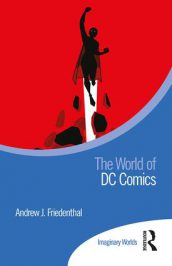When it comes to highly influential and important comic book big players, two names will be mentioned at once: DC Comics and Marvel Comics.
 While both have left their mark on the history (and the turnover) of the industry, DC Comics can be also credited with refining a giant imaginary world in which superheroes such as Batman, Wonder Woman, Superman and others would roam. DC actually invented several detailed versions of that world.
While both have left their mark on the history (and the turnover) of the industry, DC Comics can be also credited with refining a giant imaginary world in which superheroes such as Batman, Wonder Woman, Superman and others would roam. DC actually invented several detailed versions of that world.
In that case, we speak of not just a certain imaginary universe, but of a multiverse. Even though science fiction authors and writers from the 19th century already proposed the idea of parallel universes with slight contrasting natural laws, and minor differences to the known world decades earlier, as well as the nature of corresponding thought experiments, the detail of DC’s concept was extraordinary, according to author Friedenthal.
Ever since the 1940s, slowly and carefully at first, the DC authors were busy in establishing a multiverse that allowed for different versions of the superheroes to travel and switch between distinct versions of their natural environment. And “…by the end of the 1960s and beginning of the 1970s, DC (in part copying the intentional world-building continuity of rival Marvel Comics) was working deliberately to create a cohesive story world spanning multiverse full of different Earths.”
What may sound strange and extremely complex for the reader of fiction, soon was a very common thing for comic book fans, who easily understood the many creations, complications and variations of plots that happened not to just one superhero in particular, but to one version of that superhero in different universes. “What began as a bit of a slapdash connection between alternate versions of popular characters from different eras was refined, redefined, and retconned continually over time such that ultimately readers could chart and follow a unified cosmology of fictional parallel worlds composing the entirely of creation …”
Later, other media gratefully copied that concept, and it is by now almost a standard plot option in many (science fiction, mystery and the bizarre type of) TV series, movies as well as in fiction. A separate chapter here deals with this development.
However, current astrophysics does not rule out the idea of a multiverse anymore; we may currently live on just one version of Earth.
A simple example of the DC Multiverse – that actually is an infinite number of different and distinct universes – would be Superman’s fate, as Friedenthal puts it. “While one version of Superman may be young, naive, and single, able to defeat any foe save for the heartsickness he feels knowing he can never reveal his secrets to Lois Lane, another version can be older, married to Lois and have a child with her, providing different insights into the ionic character.”
This small booklet covers the main and at times complicated and not always entirely corresponding problems and (sometimes logical) errors that result from the huge amount of work of keeping an epic amount of data in full swing and have a certain theme of one superhero’s “line of work” untouched by it. So, several experts have tried to completely map DC’s Multiverse, a product of many, many creators for now almost 90 years. While right there, the original superheroes were created, although DC also published comics that dealt with WWII, adventure, cowboys, romance and other themes. So it is “… in many ways, a living, breathing entity that changes every time a new piece of story or world-building is added to it.” Hence, an entire chapter is devoted to those devotees.
For the just 104 pages of text, there is a lot of useful information and condensed wisdom (for those looking for a recipe on how to become a successful comic book publisher), addressed at not just the genre connoisseur, but the general reader.
This is a very theoretical, almost philosophical work, that in two major parts documents the history of DC and the first (1940 – 84) and second (1985 – today) phase of the multiverse. The historical part targets the key decisions and ideas. The corresponding part 2 identifies the many impulses DC’s Multiverse gave to other comic book publishers and media in general. Several brief case studies feature some works and groundbreaking ideas by creators Marv Wolfman, Geoff Johns, Gardner Fox, and Grant Morrison. However, the key elements Friedenthal mentions and identifies in many facets of this multiverse are legacy, multiplicity, expansion and play; topics referred to in all chapters.
Again: since there are so many different heroes in so many constellations with others (yes, there definitively IS confusion on many sides), to explain the central aspects of the multiverse and the quest for its origins on little more than 100 pages is quite a challenge.
Readers looking for the fate and choices a particular DC superhero had on Earth-Prime while dealing with villain A and how this changed on Earth-X, while another superhero did this or that…, this is not the text to consult. Even though there are some examples, they too illustrate the general structure, the idea of the particular universe, rather than study the individual superhero. An interesting and well written book about the nature of the DC Multiverse and is relation, or rather, its importance for the continuation of ideas, its reliability and plausibility to something called “the bigger picture.”
Andrew Friedenthal is an independent scholar, writer, and critic from in Austin, Texas. He has published numerous works on popular culture and comics.
Review by Dr. A. Ebert © 2020
Andrew J. Friedenthal. The World of DC Comics. (Imaginary Worlds series), Routledge, 2019, 118 p.
